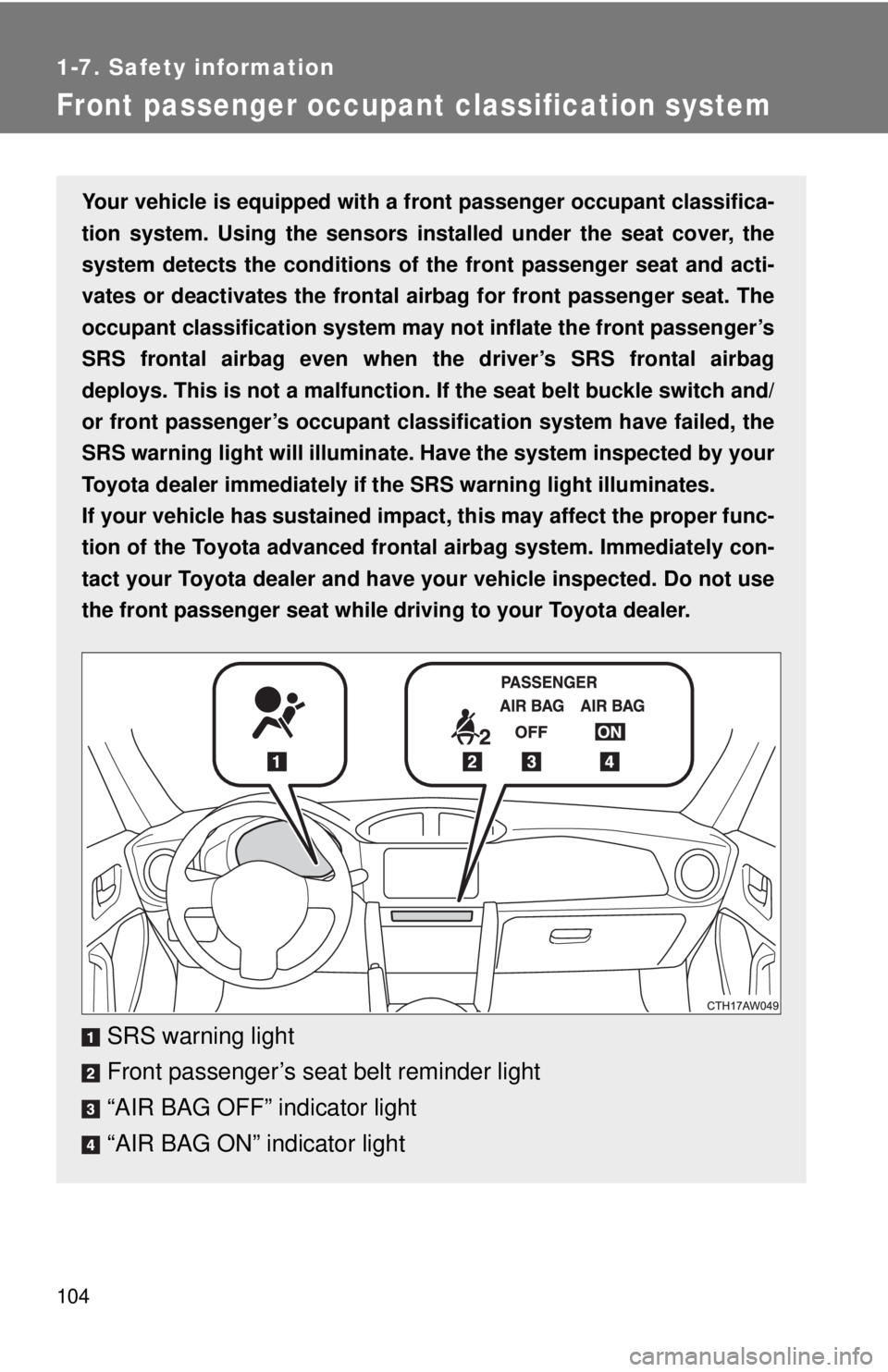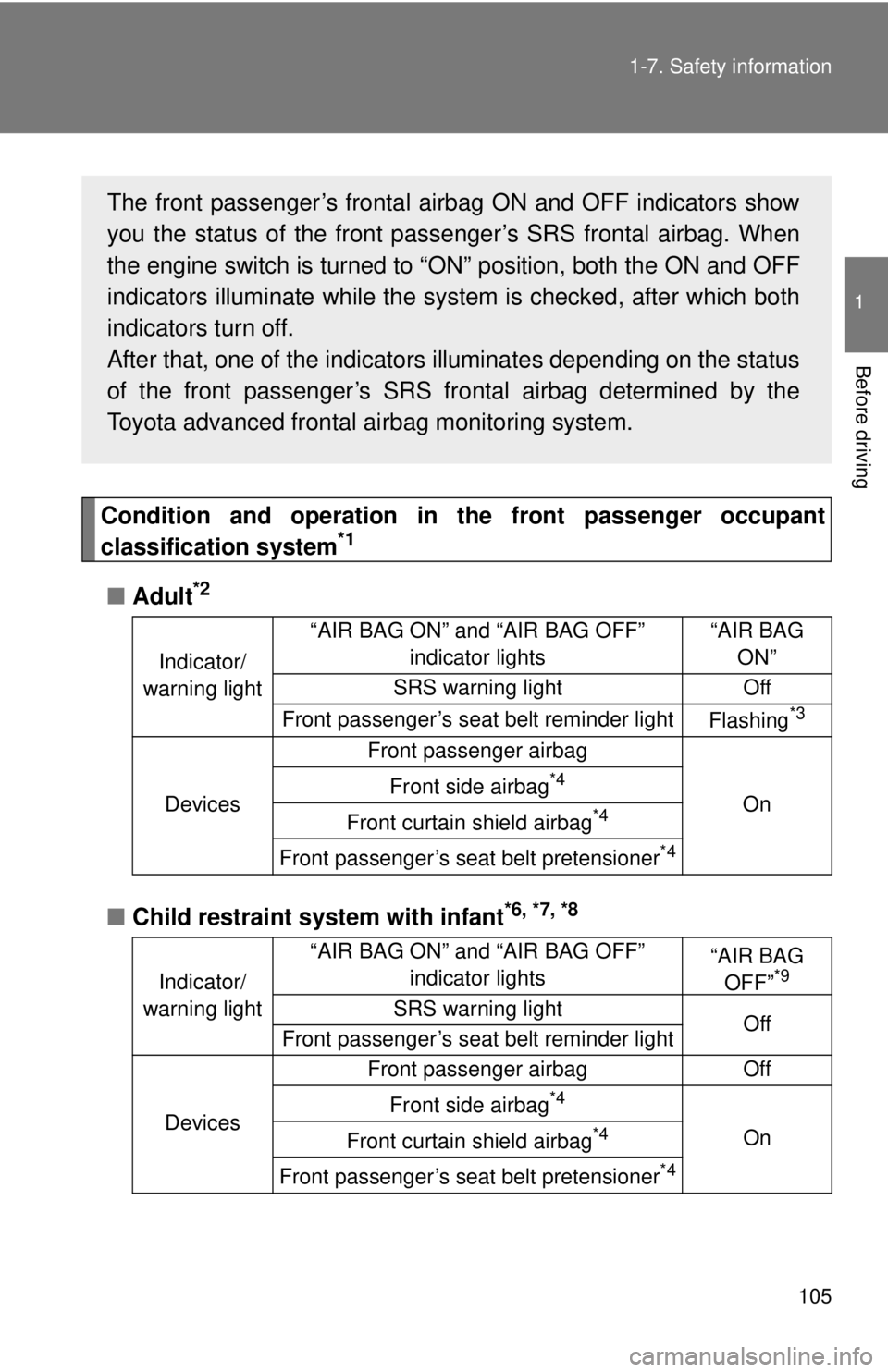TOYOTA 86 2017 Owners Manual
Manufacturer: TOYOTA, Model Year: 2017, Model line: 86, Model: TOYOTA 86 2017Pages: 428, PDF Size: 5.25 MB
Page 101 of 428

1011-7. Safety information
1
Before driving WARNING■ SRS airbag precautions
● Do not touch any of the component parts immediately after the SRS air-
bags have deployed (inflated) as they may be hot.
● If breathing becomes difficult after the SRS airbag has deployed, open a
door or window to allow fresh air in, or leave the vehicle if it is safe to do
so. Wash off any residue as soon as possible to prevent skin irritation.
● If the areas where the SRS airbags are stored, such as the steering wheel
pad and front and rear pillar garnishes, are damaged or cracked, have
them replaced by your Toyota dealer.
■ Modification and disposal of SRS airbag system components
Do not dispose of your vehicle or perform any of the following modifications
without consulting your Toyota dealer.
The SRS airbags may malfunction or deploy (inflate) accidentally, causing
death or serious injury.
● Installation, removal, disassembly and repair of the SRS airbags.
● Repairs, modifications, removal or replacement of the steering wheel,
instrument panel, dashboard, seats or seat upholstery, front, side and rear
pillars or roof side rails.
● Repairs or modifications of the front fender, front bumper, or side of the
occupant compartment.
● Installation of a grille guard (bull bars, kangaroo bar, etc.), snow plows,
winches.
● Modifications to the vehicle's suspension system.
● Installation of electronic devices such as mobile two-way radios and CD
players.
● Modifications to your vehicle for a person with a physical disability.
Page 102 of 428

1021-7. Safety information
SRS airbag system monitors
A diagnostic system continually
monitors the readiness of the
SRS airbag system (including
front seat belt pretensioners)
while the vehicle is being driven.
The SRS warning light will show
normal system operation by illu-
minating for approximately 6
seconds when the engine switch
is turned to the “ON” position.
The following components are monitored by the indicator:
● Front sub sensor (right-hand side)
● Front sub sensor (left-hand side)
● Airbag control module (including impact sensors and rollover sen-
sors)
● Frontal airbag module (driver’s side)
● Frontal airbag module (front passenger’s side)
● Side airbag sensor (center pillar right-hand side)
● Side airbag sensor (center pillar left-hand side)
● Door impact sensor (right-hand side)
● Door impact sensor (left-hand side)
● Side airbag module (driver’s side)
● Side airbag module (front passenger’s side)
● Curtain shield airbag sensor (rear wheel house right-hand side)
● Curtain shield airbag sensor (rear wheel house left-hand side)
● Curtain shield airbag module (right-hand side)
Page 103 of 428

1031-7. Safety information
1
Before driving ● Curtain shield airbag module (left-hand side)
● Satellite safing sensor (under the center of the rear seats)
● Seat belt pretensioner (driver’s side)
● Seat belt pretensioner (front passenger’s side)
● Seat belt buckle switch (front passenger’s side)
● Front passenger’s occupant classification system sensor
● Front passenger’s occupant detection control module
● Front passenger’s frontal airbag ON and OFF indicator
● All related wiring
WARNING■ SRS warning light
If the warning light exhibits any of the following conditions, there may be a
malfunction in the seat belt pretensioners, SRS airbag system and/or front
passenger occupant classification system. Immediately take your vehicle to
your nearest Toyota dealer to have the system checked. Unless checked
and properly repaired, the seat belt pretensioners, SRS airbag and/or front
passenger occupant classification system will not operate properly in the
event of a collision, which may increase the risk of death or serious injury.
● Flashing or flickering of the warning light
● No illumination of the warning light when the engine switch is first turned to
the “ON” position.
● Continuous illumination of the warning light
● Illumination of the warning light while driving
Page 104 of 428

1041-7. Safety information
Front passenger occupant classification systemYour vehicle is equipped with a front passenger occupant classifica-
tion system. Using the sensors installed under the seat cover, the
system detects the conditions of the front passenger seat and acti-
vates or deactivates the frontal ai rbag for front passenger seat. The
occupant classification system may not inflate the front passenger’s
SRS frontal airbag even when the driver’s SRS frontal airbag
deploys. This is not a malfunction. If the seat belt buckle switch and/
or front passenger’s occupant classi fication system have failed, the
SRS warning light will illuminate. Have the system inspected by your
Toyota dealer immediately if the SRS warning light illuminates.
If your vehicle has sust ained impact, this may affect the proper func-
tion of the Toyota advanced frontal airbag system. Immediately con-
tact your Toyota dealer and have your vehicle inspected. Do not use
the front passenger seat while driv ing to your Toyota dealer.
SRS warning light
Front passenger’s seat belt reminder light
“AIR BAG OFF” indicator light
“AIR BAG ON” indicator light
Page 105 of 428

1051-7. Safety information
1
Before driving
Condition and operation in th e front passenger occupant
classification system *1
■ Adult *2
■ Child restraint system with infant *6, *7, *8Indicator/
warning light “AIR BAG ON” and “AIR BAG OFF”
indicator lights “AIR BAG
ON”
SRS warning light Off
Front passenger’s seat belt reminder light
Flashing *3
Devices Front passenger airbag
OnFront side airbag *4
Front curtain shield airbag *4
Front passenger’s seat belt pretensioner *4
Indicator/
warning light “AIR BAG ON” and “AIR BAG OFF”
indicator lights “AIR BAG
OFF” *9
SRS warning light
Off
Front passenger’s seat belt reminder light
Devices Front passenger airbag Off
Front side airbag *4
On
Front curtain shield airbag *4
Front passenger’s seat belt pretensioner *4The front passenger’s frontal airbag ON and OFF indicators show
you the status of the front pass enger’s SRS frontal airbag. When
the engine switch is turned to “O N” position, both the ON and OFF
indicators illuminate while the system is checked, after which both
indicators turn off.
After that, one of the indicators illuminates depending on the status
of the front passenger’s SRS fr ontal airbag determined by the
Toyota advanced frontal ai rbag monitoring system.
Page 106 of 428

1061-7. Safety information
■ Child *5, *7
■ Unoccupied
■ There is a malfunction in the system Indicator/
warning light “AIR BAG ON” and “AIR BAG OFF”
indicator lights “AIR BAG
OFF” or “AIR
BAG ON” *5
SRS warning light Off
Front passenger’s seat belt reminder light Off or
flashing *3, *5
Devices Front passenger airbag Off or on *5
Front side airbag *4
On
Front curtain shield airbag *4
Front passenger’s seat belt pretensioner *4
Indicator/
warning light “AIR BAG ON” and “AIR BAG OFF”
indicator lights “AIR BAG
OFF”
SRS warning light
Off
Front passenger’s seat belt reminder light
Devices Front passenger airbag Off
Front side airbag *4
On
Front curtain shield airbag *4
Front passenger’s seat belt pretensioner *4
Indicator/
warning light “AIR BAG ON” and “AIR BAG OFF”
indicator lights “AIR BAG
OFF”
SRS warning light On
Front passenger’s seat belt reminder light Off
Devices Front passenger airbag Off
Front side airbag *4
On
Front curtain shield airbag *4
Front passenger’s seat belt pretensioner *4
Page 107 of 428

1071-7. Safety information
1
Before driving * 1
: The occupant classification system does not operate during self-
checking.
* 2
: The system judges a person of adult size as an adult. When a
smaller adult sits in the front passenger seat, the system may not
recognize him/her as an adult depending on his/her physique and
posture.
* 3
: In the event the front passenge r does not wear a seat belt.
* 4
: The front passenger’s SRS side airbag, SRS curtain shield airbag
and seat belt pretensioner are not controlled by the occupant
classification system.
* 5
: For some children, child in seat, child in booster seat or child in
convertible seat, the system may not recognize him/her as a
child. Factors which may affect this can be the physique or pos-
ture.
Children who have outgrown a child restraint system should
always wear the seat belt when sitting in the seat irrespective of
whether the airbag is de activated or activated.
* 6
: When a child restraint system is installed on the front passenger
seat, do not place any article on the seat other than the child
occupant and a child restraint system.
Failure to do so may prevent th e front passenger occupant classi-
fication system from functioning correctly or cause the system to
fail.
* 7
: Do not place more than one child on the front passenger seat.
Failure to do so may prevent th e front passenger occupant classi-
fication system from functioning correctly.
* 8
: Never install a rear-facing child restraint system on the front pas-
senger seat. See the caution that follows regarding installation of
a child restraint system. ( → P. 116)
* 9
: In case the indicator is not i lluminated, consult this manual on
how to installing the child restraint system properly. ( → P. 116)
Page 108 of 428

1081-7. Safety information
If the passenger’s frontal airbag OFF indicator illuminates and the ON indicator
turns off even when the front passenger’s seat is occupied by an adult
This can be caused by an adult in correctly sitting in the front passen-
ger’s seat. Perform the following.
The engine switch is turned to the “LOCK” position.
Ask the front passenger to set the seatback to the upright
position, sit up straight in the ce nter of the seat cushion, cor-
rectly wear the seat belt, posit ion his/her legs out forward, and
adjust the seat to the rearmost position.
The engine switch is turned to the “ON” position.
If the OFF indicator remains illuminated while the ON indicator
remains off, perform the following.
• The engine switch is turned to the “LOCK” position.
• Make sure that the front passenger is not using a blanket,
seat cushion, seat cover or seat heater, etc.
• If wearing excessive layers of clothing, the front passenger
should remove any unnecessary items before sitting in the
front passenger seat, or should sit in a rear seat.
The engine switch is turned to the “ON” position. After the
self-check is performed, the ON indicator should illuminate
while the OFF indicator remains off. If the OFF indicator still
remains illuminated while the ON indicator remains off, ask
the occupant to move to the rear seat and immediately con-
tact your Toyota dealer for an inspection.STEP 1
STEP 2
STEP 3
STEP 4
STEP 5
Page 109 of 428

1091-7. Safety information
1
Before driving If the front passenger’s frontal airbag ON indicator illuminates and the OFF indicator turns off
even when an infant or a small child is in a child restraint system (including booster seat)
This can be caused by the child restraint system being installed incor-
rectly. Perform the following.
The engine switch is turned to the “LOCK” position.
Remove the child restraint syst em from the seat. By referring
to the child restraint manufact urer’s recommendations as well
as the child restraint system in stallation procedure in “child
restraint system”, correctly rein stall the child re straint system.
The engine switch is turned to the “ON” position and make
sure that the front passenger’s frontal airbag ON indicator
turns off and the OFF indicator illuminates.
If the ON indicator still remain s illuminated while the OFF indi-
cator turns off, perform the following.
• Ensure that no article is pl aced on the seat other than the
child restraint system and the child occupant.
• Ensure that the backward-for ward position and seatback of
front passenger seat are locked into place securely by mov-
ing the seat back and forth.
If the ON indicator still remain s illuminated while the OFF indi-
cator turns off after taking the relevant corrective actions
described above, relocate the ch ild restraint system to the
rear seat and immedi ately contact your Toyota dealer for an
inspection.STEP 1
STEP 2
STEP 3
STEP 4
STEP 5
Page 110 of 428

1101-7. Safety information
WARNING■ Front passenger occupant classification system precautions
Observe the following precautions regarding front passenger occupant clas-
sification system.
Failure to do so may cause the occupant classification system to not function
correctly, resulting in death or serious injury.
● Wear the seat belt properly.
● Do not apply excessive force to the seat.
● Do not put sharp object(s) on the seat or pierce the seat upholstery.
● Do not put objects under the front passenger seat.
● Do not use a seat accessory, such as a cushion or seat cover, that covers
the seat cushion surface.
● Do not spill liquid on the front passenger seat. If liquid is spilled, wipe it off
immediately and dry the seat. If the airbag warning light illuminates, dry
the seat until the warning light turns off. If the airbag warning light stays on
even when the seat has dried, do not allow anyone to sit on the front pas-
senger seat and have the system checked by your Toyota dealer. If the air-
bag warning light does not illuminate, check that the airbag ON/OFF
indicator light works properly. If the indicator light does not work properly,
do not allow anyone to sit in the front passenger’s seat and have the sys-
tem inspected by your Toyota dealer.
● Do not remove or disassemble the front passenger seat. Also, do not
replace or modify the seat upholstery or foam inside the seat.
● Do not install any accessory (such as an audio amplifier) other than a gen-
uine Toyota accessory under the front passenger’s seat.
● Do not place a magnetized items near the seat belt buckle.